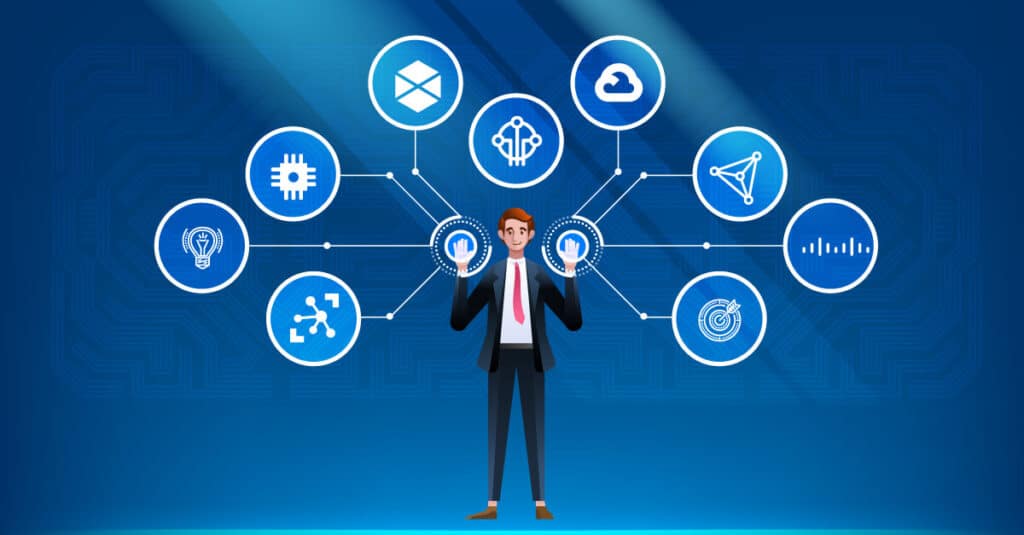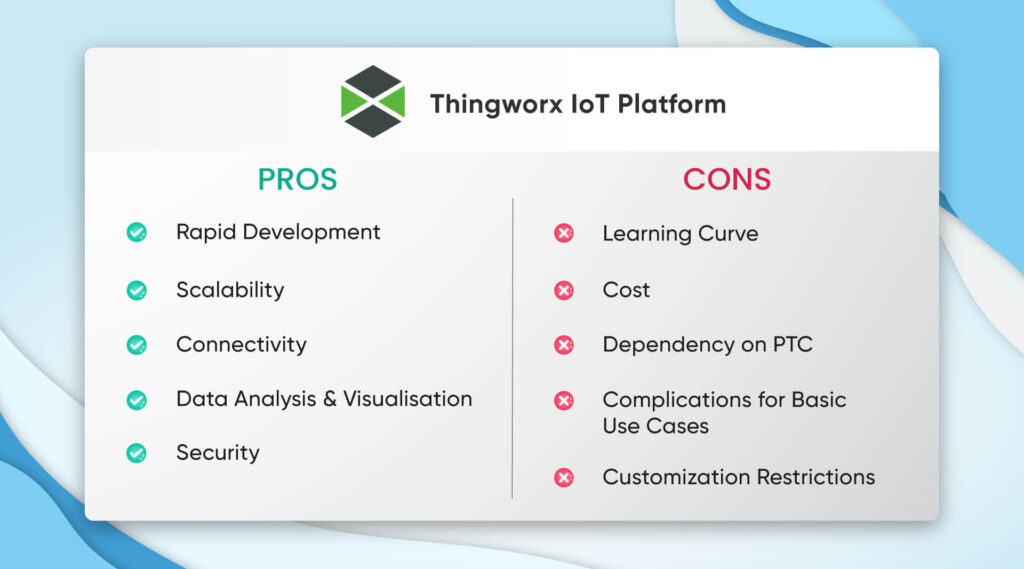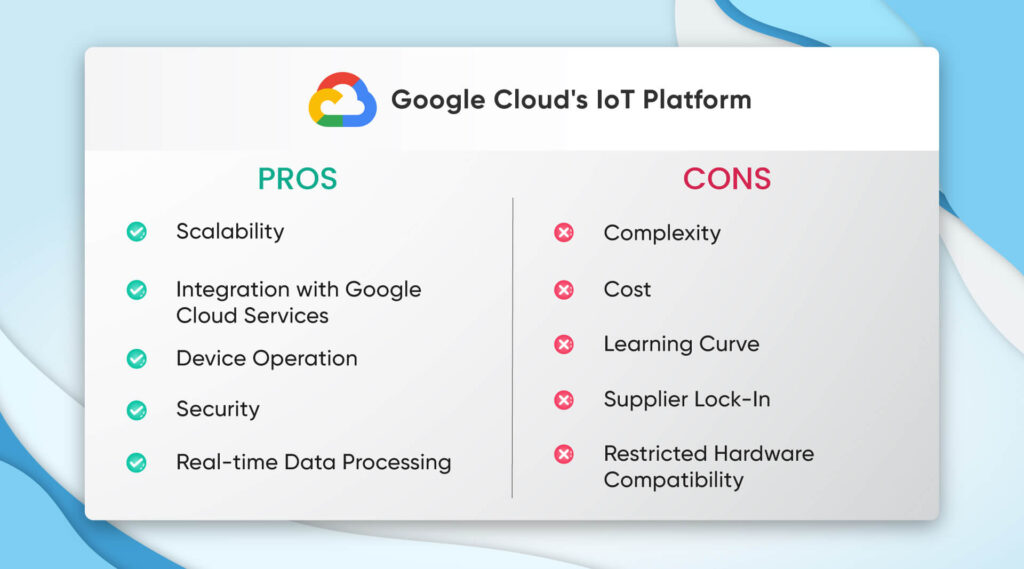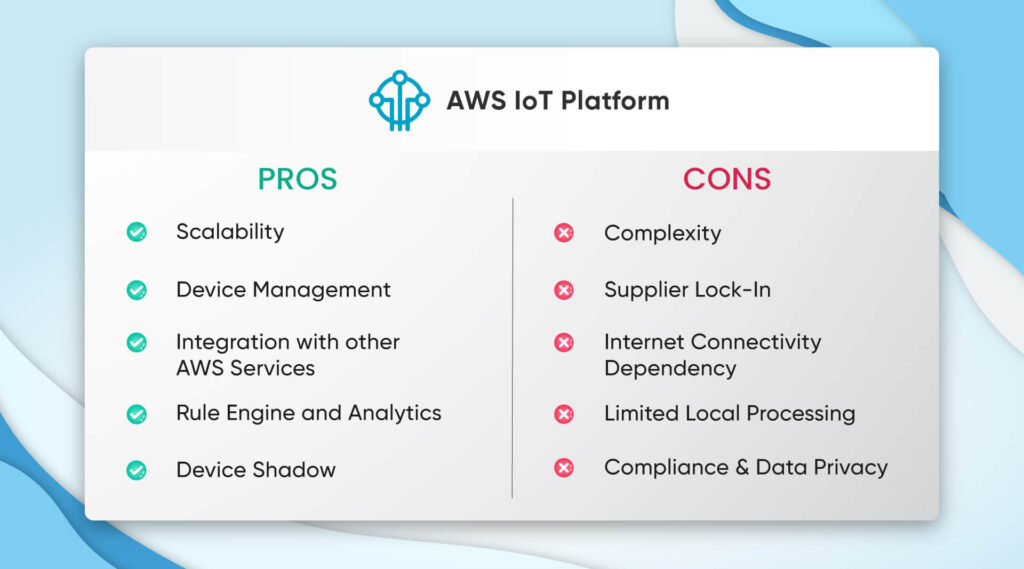Top 5 IoT development platforms in 2023

Introduction
As IoT continues to evolve rapidly. IoT developers and businesses require robust platforms that streamline the process of building and deploying IoT solutions. This blog post will delve into the top 5 IoT development platforms poised to impact 2023 significantly. These platforms offer many features and capabilities, empowering IoT developers to bring their ideas to life and drive innovation in the connected world.
IoT Architecture
The Internet of Things (IoT) has transformed how physical devices and objects interact with each other and the world around them. However, at the heart of this transformation lies the IoT architecture, a structure and reference framework that enables seamless networking, communication, and interaction. In this blog post, we will explore the different layers of IoT architecture, shedding light on their functionalities and also understand how they work together to create a cohesive IoT system.
- Perception layer: This layer has tools, sensors, and actuators that observe or interact with the world. These gadgets include temperature sensors, motion sensors, cameras, RFID tags, and more. They archive and transform actual data into digital form.
- Network layer: The network layer offers the infrastructure for communication between non-layer devices and other IoT design elements. This layer also includes wireless technologies like Wi-Fi, Bluetooth, Zigbee, and cellular networks like 3G, 4G, and 5G.
- Middleware layer: The middleware layer serves as a link between the application layer and the perception layer. It coordinates connections between devices and applications, processes data, and converts protocols. This layer makes it possible to communicate securely and effectively while ensuring platform and device compatibility.
- Application layer: The application layer of the IoT system consists of programs and services that use the collected data. These applications can have user interfaces, monitoring and control systems, machine learning methods, and data analytics. In addition, the application layer uses data from IoT devices to provide helpful information, automation, and control.
- Business layer: The business layer utilizes IoT data insights to compose organizational procedures, guidelines, and tactics. This covers information management, security procedures, and IoT integration into business systems. This layer ensures the IoT deployment aligns with the organization’s goals and objectives.
What is an IoT development platform?
A software framework, and IoT development platform, not only make designing, deploying, and managing IoT applications easier but also can help you do many things easily. You can control devices, analyze data, connect to networks, work with other systems, maintain security and privacy, use tools to create applications, and handle big projects effortlessly. Hence, IoT developers can save time, use pre-built components, and concentrate on coming up with novel solutions by using an IoT platform.
Top 5 IoT development platforms
1. Thingworx 8 IoT platform

ThingWorx 8 is a PTC IoT app development platform for developing, deploying, and managing IoT applications. It also supports various networking options and device management features.
The platform enables real-time data collection, secure storage, and analytics for visualization. Additionally offers a user-friendly development terrain and supports integration with enterprise systems.
Furthermore, ThingWorx 8 ensures security through authentication and encryption mechanisms, making it a comprehensive result for IoT implementation.
Pros:
- Rapid Development: ThingWorx 8 offers many tools, libraries, and ready-made components that speed development. Also, this IoT application development platform has a drag-and-drop feature that makes it easy to create IoT applications. You don’t have to write a lot of code. This speeds up the process, enabling IoT developers to develop and launch applications in the market sooner.
- Scalability: The ThingWorx 8 platform is designed to support a wide range of IoT installations. It can handle a large number of devices and data streams, whether it’s for small test projects or large enterprise deployments.
- Connectivity: The platform can connect to networks using protocols like MQTT, HTTP, RESTful APIs, and more. The device can easily integrate with different systems, sensors, and devices. This helps it to communicate and gather information from many different sources.
- Data Analysis and Visualisation: ThingWorx 8 includes strong analytics capabilities to handle and analyze historical and real-time data from IoT devices.
- Security: Any IoT solution must consider security as a critical component. ThingWorx 8 includes robust security features like access control, encryption, authentication, and authorization altogether.
Cons:
- Learning Curve: While ThingWorx 8 provides various development tools, understanding the platform’s concepts and capabilities may require some initial training.
- Cost: Some companies need to remember that ThingWorx 8 is a platform that makes a profit. This is especially important for small businesses or startups that have limited money. Consider ed licensing fees as well as additional charges for customization or support.
- Dependency on PTC: ThingWorx 8 is a platform made by PTC that only they control. So the users depend on the company for updates, maintenance, and future development. If the company changes its plans or stops supporting the platform, users may have concerns because they rely on it.
- Complications for Basic Use Cases: ThingWorx 8 can handle large IoT projects, but it might be too complex for simple tasks like displaying data and basic networking. So in such situations, opting for a simpler and more affordable platform could be a better choice.
- Customization Restrictions: Even though ThingWorx 8 has many ready-made parts, adjustments or specific needs might arise. The extent of the alteration will determine whether additional development effort or integration with external systems is necessary.
2. Microsoft Azure IoT Suite

Microsoft Azure IoT Suite is a platform on the cloud that helps connect and operate IoT devices. It also lets you analyze data and connect with AI services. It helps organizations securely connect and handle their IoT devices on a large scale.
The platform not only supports protocols but also offers device enrollment, provisioning, and configuration features. It allows ingestion and storehousing of large volumes of IoT data, with real-time and batch analytics capabilities for extracting visualizations.
Azure IoT Suite integrates with Azure’s machine literacy and AI services, enabling advanced analytics and prophetic capabilities. It also prioritizes security with the device-position security mechanisms and identity operation features.
Pros:
- Scalability: Azure IoT Suite handles big deployments easily. It can connect and manage millions of devices without any hassle. It also offers robust backend services, including data storage, analytics, and machine literacy capabilities, to support the growth of your IoT result.
- Integration with Azure Services: This includes Azure Functions, Azure Stream Analytics, and Azure Machine Learning. This integration enables you to work fresh capabilities and make end-to-end results encompassing IoT, data processing, and business sense.
- Device Management: Azure IoT Suite provides expansive device operation capabilities, allowing you to cover, configure, and update IoT devices at scale. You also can set up, control firmware, and monitor device health.
- Security and Compliance: Azure IoT Suite not only provides robust security features for your devices, data, and communications but also provides authentication, encryption, and part-grounded access control mechanisms to ensure secure data transmission and access.
- Analytics: Azure IoT Suite offers essential analytics capabilities to reuse and dissect the massive quantum of data IoT devices generate. You can work with Azure Stream Analytics and Machine Learning to gain precious visualizations, describe patterns, and make data-driven opinions.
Cons:
- Complexity: The platform can take a lot of work to learn. It might require significant time and effort for inventors to become skilled at using Azure services and APIs.
- Cost: While Azure IoT Suite offers various pricing options, planting and running IoT results on a large scale can be precious. Costs can increase, especially when dealing with many devices, data storage, and high-frequency data processing.
- Dependency on the Cloud: This platform depends on the cloud, meaning the cloud services need an internet connection for IoT devices to communicate. If your internet connection is limited or unreliable, using cloud services in your IoT projects can create issues and interruptions.
- Supplier Lock-In: You rely on Microsoft’s ecosystem and personal technologies when using Azure IoT Suite. Moving down from Azure IoT Suite may involve significant trouble and implicit comity issues.
- Support and Documentation: Microsoft offers a lot of support and resources for Azure IoT Suite.
3. Google Cloud’s IoT platform

Google Cloud IoT Core is a comprehensive IoT app development platform that securely connects and manages devices. It supports various connectivity protocols, device management features, and seamless integration with other Google Cloud services.
The platform ensures data ingestion and processing at scale, with strong security and identity management measures. It offers global scalability and has a different partner ecosystem.
Google Cloud IoT Core empowers businesses to build scalable and secure IoT results across industries.
Pros:
- Scalability: Google Cloud has built an IoT platform that handles many IoT devices and data pipelines easily. Furthermore, it can scale up as needed, ensuring effective management of devices and data. It can also accommodate the growth of your IoT deployment as your requirements expand.
- Integration with Google Cloud services: Google Cloud’s IoT platform seamlessly integrates with other services handled by Google Cloud, similar to BigQuery, Dataflow, and Machine Literacy.
- Device operation: The platform offers robust device operation capabilities, including device enrollment, configuration, and over-the-air ( OTA) firmware updates.
- Security: Google Cloud’s IoT platform not only provides erected-in security features to cover your IoT devices and data but also offers end-to-end encryption, authentication, and authorization mechanisms to ensure secure communication between devices and the cloud.
- Real-time data processing: The platform helps you quickly respond to events and make decisions based on real-time information from your IoT data. It also supports the ingestion and processing of data in real-time. This can be pivotal for time-sensitive operations and use cases.
Cons:
- Complexity: For newcomers, Google Cloud’s IoT platform can be complex for druggies new to IoT or cloud technologies.
- Cost: Google Cloud’s IoT platform has different pricing options, such as pay-as-you-go and dedicated plans. By using the platform, you can avoid costs, especially when your IoT deployment grows larger.
- Learning Curve: The platform is part of Google Cloud. Learning and using all the features and services may take some time.
- Supplier Lock-In: By espousing Google Cloud’s IoT platform, you become dependent on Google’s structure and services.
- Restricted hardware compatibility: Google Cloud’s IoT platform can work with various devices, protocols, and connecting ways. However, it’s important to note that there could be some limitations when handling large amounts of data.
4. IBM Watson IoT platform

IBM Watson IoT app development Platform is a cloud-based platform that facilitates the connection, operation, and analysis of IoT devices. In addition, it offers device connectivity, data operation, analytics, and visualization capabilities, allowing associations to decide precious information from IoT data.
The platform supports rule-grounded conduct and automation, enabling druggies to spark responses based on device data. It also provides tools and APIs for application development and integrates with IBM Watson AI services and other systems.
IBM Watson IoT Platform not only helps organizations maximize the potential of IoT but also improves operational efficiency by prioritizing security and device functionality.
Pros:
- Scalability: The IBM Watson IoT platform is mainly scalable, allowing businesses to seamlessly connect and manage many IoT devices.
- Advanced Analytics: The platform incorporates IBM Watson’s cognitive computing capabilities, enabling advanced analytics and machine literacy.
- Security: IBM demonstrates a solid commitment to security. The Watson IoT platform also has robust security features that protect IoT devices and data.
- Integration with Other IBM Services: The Watson IoT platform integrates seamlessly with other IBM services and results, similar to Watson Analytics, Watson Studio, and IBM Cloud.
- Industry-Specific Solutions: IBM Watson IoT provides assiduity-specific results and accelerators adapted to various sectors like manufacturing, healthcare, transportation, and more.
Cons:
- Complexity: Enforcing and managing an IoT ecosystem can be complex, and the Watson IoT platform is no exception. Whereas it requires a particular position of specialized expertise to set up and configure the platform effectively.
- Cost: The Watson IoT platform is a significant and advanced solution for businesses. However, it can cost a lot for small businesses or startups with limited budgets.
- Learning Curve: The Watson IoT platform has advanced analytics capabilities. Learning to use cognitive capabilities effectively and interpreting the analytics labors may require training or expertise in data analysis.
- Supplier Lock-In: IBM Watson IoT platform may lead to seller cinch-heft. Switching to a different IoT platform or provider could involve significant migration sweats and costs.
- Limited Device Support: The Watson IoT platform can work with different devices and protocols. However, there may be some restrictions on device compatibility.
5. AWS IoT platform

The AWS IoT platform by Amazon Web Services is an overall collection of services and tools for making and controlling IoT applications. It offers a safe and expandable framework for connecting devices and gathering data.
It also offers device management capabilities and a high-performing MQTT broker for effective messaging. Security features ensure data protection and device authentication.
Pros:
- Scalability: AWS IoT offers a vastly scalable structure, allowing you to connect and manage billions of devices securely. Surprisingly it can handle large-scale deployments and accommodate unborn growth without compromising performance.
- Security: AWS IoT incorporates robust security features, including end-to-end encryption, device authentication, and access control programs.
- Device Management: The platform offers comprehensive device operation capabilities, enabling you to control and examine IoT devices.
- Integration with Other AWS Services: AWS IoT connects easily with other AWS services such as AWS Lambda, AWS DynamoDB, and AWS S3. This allows you to complete important IoT tasks quickly.
- Rule Engine and Analytics: AWS IoT provides a rule machine that allows you to define and execute conduct grounded on incoming device data.
- Device Shadow: AWS IoT supports device shadows, which are virtual representations of physical devices. Shadow enables you to maintain and attend to the state of devices when they’re offline.
Cons:
- Complexity: As with any comprehensive IoT platform, AWS IoT has a literacy curve and can be complex to set up and configure.
- Cost: AWS IoT services can increase costs, especially as the number of connected devices and data volume grows.
- Supplier Lock-In: You come tied to AWS services and structure by espousing the AWS IoT platform. Therefore migrating to a different platform or cloud provider may involve significant trouble and affect the functionality of your IoT result.
- Internet connectivity dependency: AWS IoT depends on internet connectivity to communicate between devices and the cloud. However, if the network encounters issues or certain areas have limited internet connectivity, it can impact the performance of your IoT devices.
- Limited Local Processing: AWS IoT offers cloud-based processing capabilities, but specific scripts might prefer processing data directly on edge.
- Compliance and Data Privacy: When using AWS IoT, it’s important to consider data sequestration and compliance conditions specific to your operation and assiduity.
Conclusion
Conclusion
Thinkitive is a leading provider of an exceptional IoT platform solution . Their robust features and capabilities empower IoT developers to streamline the process of building and deploying IoT solutions. Thinkitive helps businesses innovate, stay competitive, and improve customer interactions in the evolving IoT landscape in 2023 and beyond.
Frequently Asked Questions
The four types of IoT platforms are:
- Connectivity Management Platforms
- Device Management Platforms
- Application Enablement Platforms (AEPs)
- Data Analytics Platforms
The best platform for IoT ultimately depends on the specific requirements and uses the case of your IoT project. Different platforms have strengths and capabilities that may be more suitable for specific applications. Some popular and highly regarded IoT platforms include:
- AWS IoT Core
- Microsoft Azure IoT Suite
- Google Cloud’s IoT platform
- IBM Watson IoT Platform




